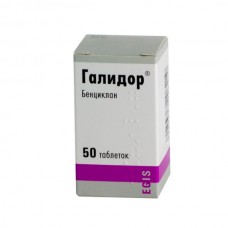Expiration date: 01/2026
Structure and Composition:
Tablets. 1 tablet contains Bencyclane fumarate 100 mg
Excipients: potato starch polyvinyl magnesium stearate, carbomer 934P sodium carboxymethyl starch (type A), silica colloidal anhydrous Talc
Patients in dark glasses to 50 pcs. in a cardboard box 1 bottle.
Solution for in / and the / m. 1 vials cintains Bencyclane fumarate 50 mg
Excipients: sodium chloride for parenteral dosage forms of the water for injection
in blisters 5 ampoules of 2 ml in a cardboard box 2.
Description pharmaceutical form:
Tablets: white or grayish-white, round, flat, bevelled, engraved with «HALIDOR» on one side, with a weak characteristic odor.
Solution for injection: clear, colorless solution, odorless.
Pharmacokinetics:
Bencyclane well absorbed from the gastrointestinal tract. Cmax plasma levels achieved after 2-8 hours (usually within 3 hours) following oral administration. Because the first pass metabolism through the liver, the bioavailability of the drug after oral administration is 25-35%. Approximately 30-40% of the amount of blood circulating in Bencyclane bound to plasma proteins, 30% - with red blood cells, 10% - platelet-free fraction is 20%. Metabolism in the liver mainly in two ways: dealkylation gives demethylated derivative and the ether bond cleavage gives benzoic acid, which is further converted to hippuric. The main part of the administered dose is excreted in the urine primarily as metabolites in unmodified form - 3.2%.
A significant amount of the metabolites (90%) is released in unconjugated form, and a small part is released into the conjugated form (about 50% - in the form of a conjugate with glucuronic acid).
T1 / 2 is 6-10 hours, this option does not change in elderly patients, as well as in violation of the kidneys and liver. The total clearance is 40 l / h, renal clearance - less than 1 l / h.
Description of the pharmacological actions:
Bencyclane - Myotropic antispasmodic with a pronounced vasodilating action. Bencyclane vasodilator effect is mainly due to its ability to block calcium channels antiserotoninovym action and to a lesser extent - to the blockade of sympathetic ganglia. In addition, Bencyclane has antispasmodic action on the visceral muscles (gastrointestinal, urinary, respiratory). The drug causes a slight increase in heart rate. We also know his weak tranquilizing effect.
Mechanism of action. Bencyclane can cause dose-dependent inhibition of Na / K ATPase and -dependent platelet aggregation and red blood cells, red blood cells and increase elasticity. These effects are observed mainly in peripheral vessels, coronary and cerebral vessels.
Testimony:
- vascular disease: Peripheral vascular disease - Raynaud's disease and other diseases with a Crocq's disease and vascular spasm, and chronic obliterating diseases of arteries of cerebral vascular disease - in the treatment of acute and chronic cerebral ischemia
- elimination of spasm of the internal organs: gastrointestinal diseases - gastroenteritis of various etiologies (especially infectious), infectious and inflammatory colitis, functional disorders of the colon, tenesmus, postoperative flatulence, cholecystitis, cholelithiasis, post-cholecystectomy, dysmotility at dyskinesia sphincter of Oddi , gastric ulcer or duodenal ulcer - in combination with other drugs urological syndromes: cramps and tenesmus of the bladder, concomitant therapy of urolithiasis - in combination with analgesics in renal colic.
Additionally for solution for injection: preparation for instrumental methods in urology.
Contraindications:
- Hypersensitivity to the active or any other component of the drug
- severe respiratory, renal or hepatic impairment
- decompensated heart failure, acute myocardial infarction, AV block.
- paroxysmal supraventricular or ventricular tachycardia
- epilepsy or other forms spazmofilii
- recent history of hemorrhagic stroke
- Head injury (within past 12 months)
Pregnancy
breast-feeding (see. "Pregnancy and breast-feeding" section)
Children up to age 18 years (due to lack of clinical data).
Application of pregnancy and breastfeeding:
These pre-clinical studies have not revealed any embryotoxic or teratogenic effects. However, sufficient reliable research on the use of the drug during pregnancy and lactation has not been conducted in humans. Therefore, the introduction of the drug to patients in the I trimester of pregnancy is not recommended. During the period of lactation should be avoided on the purpose of the drug, or to resolve the issue of termination of breastfeeding during treatment.
Side effect:
From the digestive tract: dry mouth, abdominal pain, feeling of fullness, loss of appetite, nausea, vomiting, diarrhea (tablets).
CNS: anxiety, headache, dizziness, gait, tremors, insomnia, memory loss, rarely - transient confused state of consciousness, hallucinations, asthenia (tablets), very rarely - focal CNS symptoms, epileptiform seizures.
Since the cardiovascular system: it may sometimes be atrial or ventricular tachyarrhythmias (especially when co-administered with other drugs proaritmogennoe).
Laboratory parameters: transient increase in ALT and AST, leucopenia.
Other: general malaise, weight gain, allergic reactions, rarely - thrombosis with / in the introduction (injection).
Drug Interactions:
Use caution when combined with the following means:
- Anesthetics and sedatives - their effects may be intensified
- Sympathomimetics - because of the risk of atrial and ventricular tachyarrhythmias
- Means of lowering blood levels of potassium and quinidine - because of the possible effects of summation proaritmogennoe
- Digitalis drugs - increases the risk of arrhythmia in overdose of digitalis
- Beta-blockers - because opposites chronotropic effects (negative from beta-blockers and have a positive Bencyclane) may need to matching the dosage of beta-blocker
- Calcium channel blockers and other antihypertensive drugs - because of the possibility to increase their effect
- Drugs that cause side effects such as spazmofilii - because of the possibility of summation of these effects
- Acetylsalicylic acid - due to increased inhibition of platelet aggregation.
Dosage and administration:
Pills
Inside.
Disease. According to Table 1. 3 times a day for 2-3 months. The maximum daily dose - 400 mg. The interval between treatments should be 2-3 months.
Removing spasm of the internal organs. Table 1-2. mono-, not more than 4 tablets. per day. For maintenance therapy - 1 table. 3 times per day for 3-4 weeks, then - Table 1. 2 times a day. The duration of treatment is determined individually by the disappearance of symptoms and usually should not exceed 1-2 months.
Solution / v injection
B / in (after dilution), infusion.
Disease. Vascular diseases the preparation may be applied in a daily dose of 200 mg, divided into 2 infusion. 100 mg (4 ml) of the drug is diluted in 100-200 ml of isotonic sodium chloride solution. The drug is injected in / in infusion over 1 hour, 2 times a day.
Removing spasm of the internal organs. B / injection. In acute cases intravenously administered slowly 4.8 ml (2-4 ampoules) preparation diluted with saline or up to 10-20 ml / m (deep) 2 ml.
The course of treatment - 2-3 weeks, if necessary, followed by transfer of the patient to receive the drug Halidorum tablets.
Overdose:
Symptoms: increased frequency of heart rate, decreased blood pressure, collapse, urinary incontinence, somnolence, anxiety, and in severe cases - epileptiform seizures. A large overdose can cause tonic-clonic seizures.
Treatment: In case of overdose of pills - gastric lavage. Conduct symptomatic therapy. For the treatment of seizures recommended benzodiazepines. Data on possible breeding Bencyclane by dialysis there.
Special instructions:
Tablets. Bencyclane prolonged therapy recommended regular monitoring of rheological properties of blood (about 1 every 2 months).
In an application with drugs that cause hypokalemia, cardiac glycosides, drugs, providing a depressing effect on the myocardium, Halidorum daily dose should not exceed 150-200 mg.
Injection. Injection sites should be changed periodically, as the drug could cause damage to the vascular endothelium and thrombophlebitis.
It should refrain from injecting the drug to patients with severe cardiovascular or respiratory failure, prone to collapse, as well as hypertrophy of the prostate and urinary retention (retention rate is increased by relaxing the bladder muscle).
regular laboratory tests (at least once every 2 months) is recommended during prolonged therapy Bencyclane.
Effects on ability to drive vehicles and management mechanisms. At the beginning of the treatment course driving vehicles and works with an increased risk of accidents requires special care.



